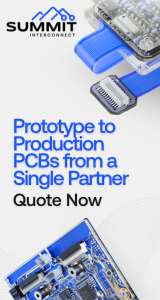|

|
|
| Ask the Experts | |||||||
|
|||||||
|
November 28, 2017 - Updated March 17, 2008 - Originally Posted Bake for RepairHow much time is required to bake a mobile phone PCB assembly to eliminate the moisture inside, before doing any repair work on the components? K. L. |
|||||||
| Expert Panel Responses | |||||||
|
I would suggest you check the PCB bill of materials and base your bake time and temperature on the MOST moisture sensitive component on the board. If this information is not available you could bake the assembly for 24 hours.
Regional Sales Manager OK International Inc. Ed Zamborsky is a Regional Sales & Technical Support Manager for Thermaltronics, located in New York. His position requires frequent customer visits throughout North America and the Caribbean and his position encompasses not only sales but the role of trainer and master applications engineer for all of Thermaltronics products. His expertise includes such specialties as hand soldering, convection and conduction reflow techniques, array rework, fluid dispensing equipment, and fume extraction. Ed has authored many articles and has presented many papers on topics such as; Low Volume SMT Assembly, Solder Fume Extraction, SMT Rework, BGA Rework, Lead-Free Hand Soldering, High Thermal Demand Hand Soldering, Lead Free Visual Inspection and Lead Free Array Rework.
Depending on the material of the PCB and the thickness, I would recommend a bake time on no more than 10 to 15 minutes.
Global Segment Manager Air Products & Chemicals, Inc. Mr. Arslanian has been involved in electronics packaging processing and equipment since 1981 including flipchip, TAB, wirebonding and die attach. Current responsiblities include R&D, applications, marketing and customer interaction.
I suggest you refer to IPC/JEDEC J-STD-033B.1. Table 4-1 of this industry standard provides reference conditions for drying moisture sensitive devices (MSDs) that have exceeded their allowable exposure time. This table is applicable to both unmounted and mounted MSDs. A bake temp of 90C is usually recommended for drying the MSDs already mounted on a PCBA, prior to rework. The higher bake temp of 125C is NOT generally recommended for PCB Assemblies, because the plastic shrouds on common headers & connectors (which may have been added post-reflow), cannot withstand long-term exposure to 125C. The required bake duration at 90C ranges from 11 hours to 10 days, depending on the following 3 variables: 1) Moisture Sensitivity Level (MSL) of the MSD(s) on the board. 2) MSD Package Body Thickness 3) Elapsed time since expiration of Floor Life of MSDs on the PCBA. If this is unknown, then the safe bet is to use the column entitled "Exceeding Floor Life > 72 hours". Based on the above 3 variables, Table 4-1 provides all the information your readers need to ensure MSDs on PCB Assemblies can be sufficiently dried, to survive thermal excursions during rework and repair operations.
Sales Manager (Americas) Cogiscan, Inc. Mitch DeCaire, Sales Manager at Cogiscan, has served the electronics manufacturing industry since 1989. His prior experiences include process engineering, business development, and engineering management roles with Nortel Networks, Vansco Electronics, Universal Instruments and Siemens.
Unfortunately, there isn't a simple answer to your question. Let's take a detailed view of your inquiry.
Director of Engineering Innovative Drying Co. Mr. Leech lead a successful 2 year long process development effort that identified the parameters required to rapidly dry moisture sensitive devices while they were encased in the tape and reel format. Mr. Leech has over thirty years of experience as a manufacturing engineering manager in the electronics industry.
NOTE: Mr. Leech is no longer working at Innovative Drying Co. Definitely you have few variables on this problem statement - how much time the board was out for, what is the material spec, what is the population type on the board, board thickness, etc. For the PCB itself the supplier is the one that can give you the exact specs and recommendations for the baking process. However when you perform the baking I recommend a vacuum bake - this will allow you to use below water boiling point temperature to dry the moisture out.
Engineering and Operations Management Independent Consultant Georgian Simion is an independent consultant with 20+ years in electronics manufacturing engineering and operations.
Contact me at georgiansimion@yahoo.com. |
|||||||
| Submit A Comment | |||||||
|
Comments are reviewed prior to posting. You must include your full name to have your comments posted. We will not post your email address. |
|
Free Newsletter Subscription
Circuitnet is built for professionals who bear the responsibility of looking ahead, imagining the future, and preparing for it. Insert Your Email Address |
|

|





